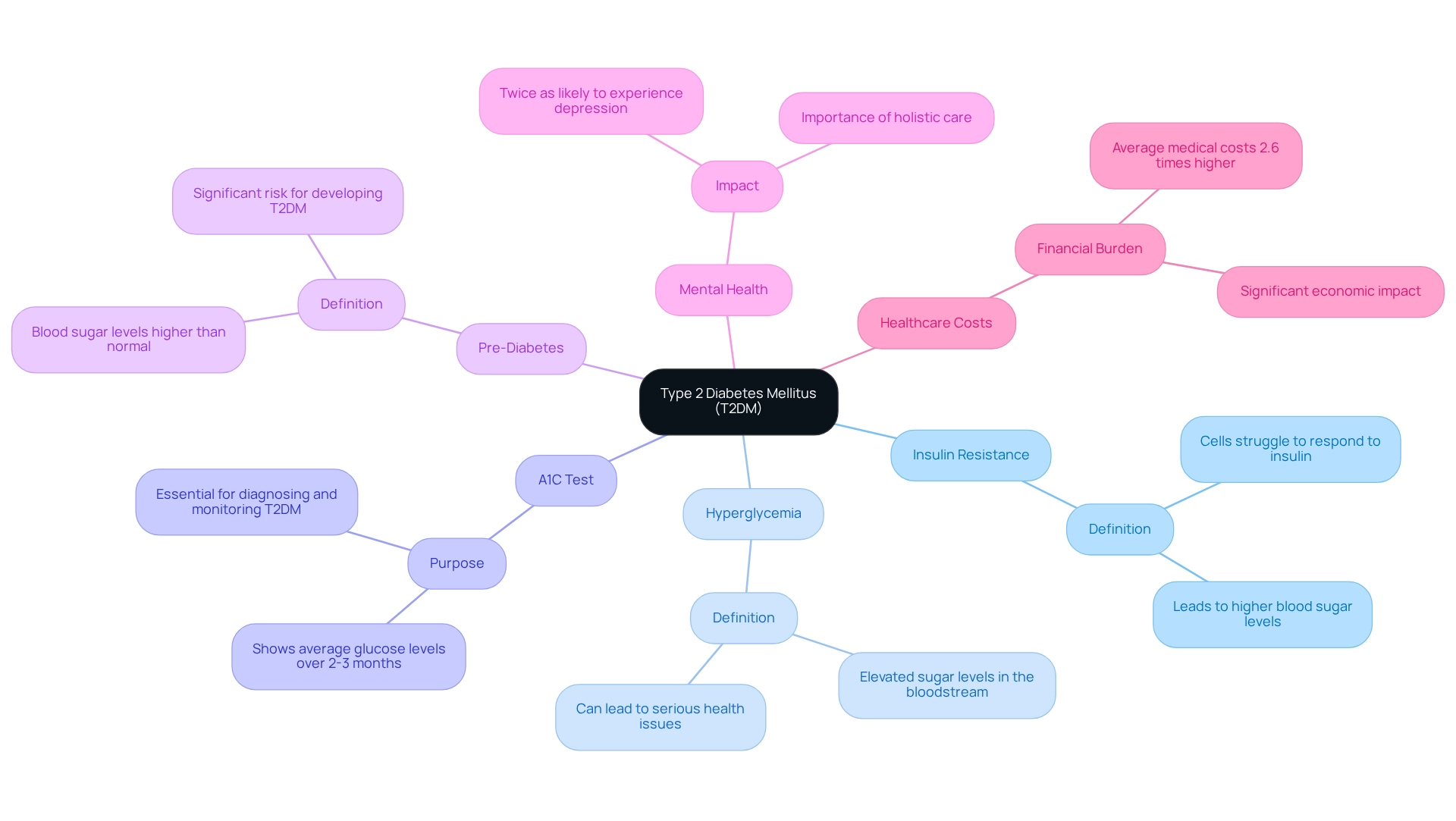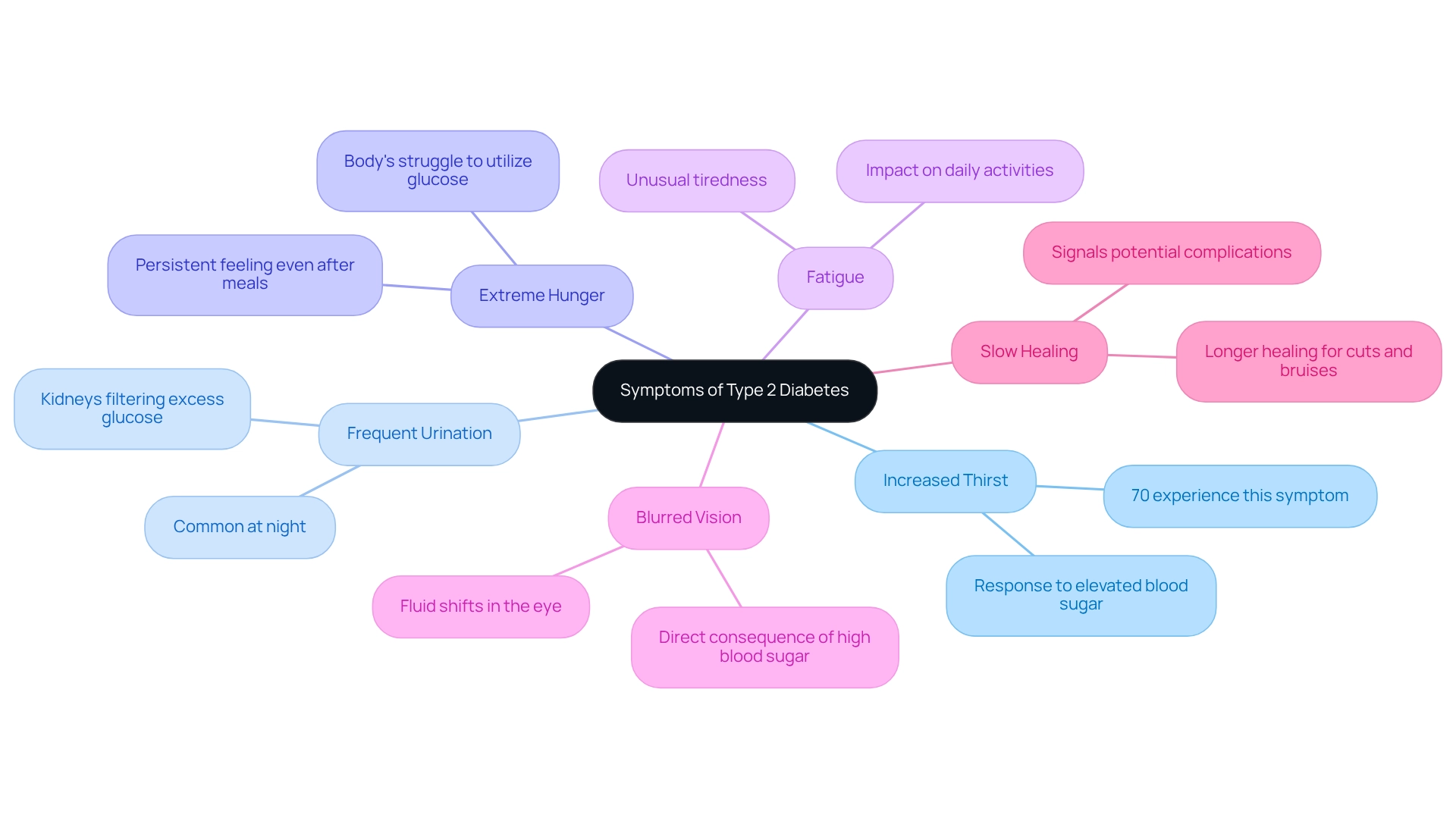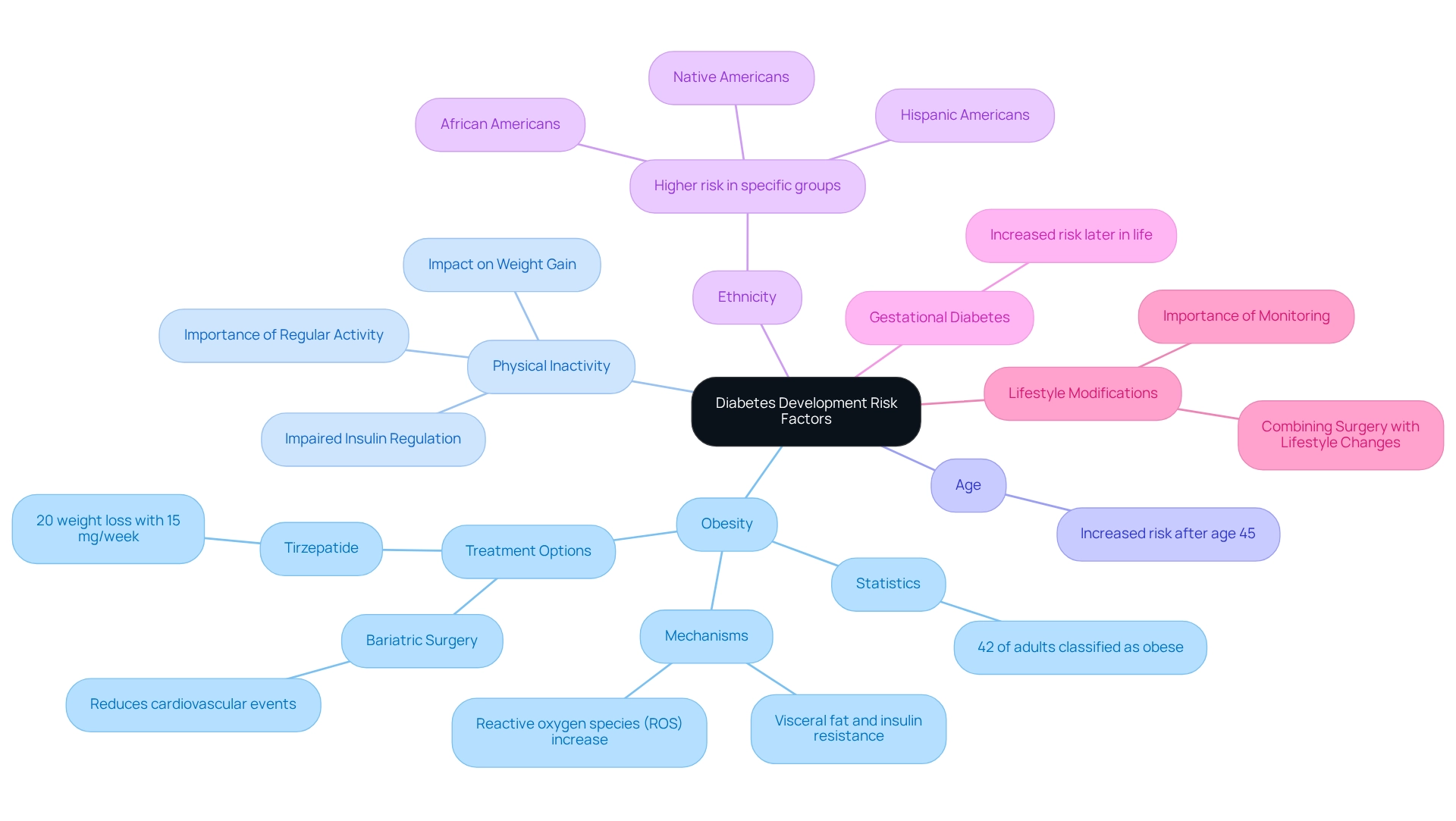Overview
The article "Understanding Diabetes Type 2 Mellitus: Symptoms, Causes, and Management" offers a compassionate overview of Type 2 Diabetes, focusing on its symptoms, causes, and effective management strategies. It’s crucial to recognize symptoms early, as this can significantly impact your journey. Lifestyle factors, such as obesity and inactivity, play a vital role in the development of diabetes, and understanding this can help you make informed choices.
A multifaceted approach to management is essential. This includes:
- Adopting a healthy diet
- Engaging in regular exercise
- Considering medical interventions
By taking these steps, you can empower yourself to take control of your health. Remember, you're not alone in this journey; many resources and support systems are available to guide you along the way.
We encourage you to explore these strategies and reach out for support when needed. Together, we can navigate the complexities of diabetes management and foster a healthier future.
Introduction
In a world where Type 2 Diabetes Mellitus (T2DM) is becoming increasingly prevalent, understanding its complexities is more important than ever. This chronic condition, characterized by insulin resistance and elevated blood sugar levels, is often linked to lifestyle choices such as diet and physical activity. It's understandable to feel overwhelmed as you navigate the intricacies of managing T2DM. Recognizing early symptoms, identifying risk factors, and implementing effective management strategies are crucial steps in this journey.
From the significance of lifestyle modifications to the role of medical interventions, this comprehensive exploration sheds light on the vital steps necessary for effective diabetes management. Remember, you’re not alone in this journey. Community support is essential in fostering resilience among those affected, and together, we can take meaningful steps toward better health.
Define Type 2 Diabetes Mellitus: Key Concepts and Terminology
Diabetes type 2 mellitus (T2DM) is a long-term condition that can feel overwhelming, characterized by insulin resistance and relative insulin deficiency, which leads to increased glucose levels in the bloodstream. Diabetes type 2 mellitus is often linked to obesity and a sedentary lifestyle. Understanding some key concepts can empower you on this journey:
- Insulin Resistance: This happens when your body’s cells struggle to respond to insulin, making it difficult for glucose to enter the cells and leading to higher sugar levels in your blood.
- Hyperglycemia: This term describes elevated sugar levels in your system. If left unmanaged, it can lead to serious health issues, including cardiovascular disease and nerve damage.
- A1C Test: This important test shows your average glucose levels over the past 2 to 3 months. It’s essential for diagnosing and monitoring diabetes type 2 mellitus, with a recommended A1C level below 7% for optimal management. Experts agree that the A1C test is a vital tool for assessing long-term glucose control and guiding treatment decisions.
Pre-diabetes is marked by blood sugar levels that are higher than normal but not yet high enough to be classified as diabetes type 2 mellitus, indicating a significant risk for developing diabetes type 2 mellitus. Current statistics reveal that diabetes type 2 mellitus often peaks around the age of 55, highlighting the importance of early detection and intervention. Additionally, those living with diabetes type 2 mellitus incur average medical costs that are 2.6 times higher than those without the condition, underscoring the financial challenges associated with managing diabetes type 2 mellitus.
Research shows that insulin resistance plays a pivotal role in the development of diabetes type 2 mellitus. Addressing this resistance can lead to improved patient outcomes. For example, effective management of hyperglycemia often includes lifestyle changes such as diet and exercise, which can enhance insulin sensitivity. Projections indicate that by 2025, the prevalence of insulin resistance will continue to rise, making it crucial to focus on effective management strategies.
Moreover, it’s essential to recognize the mental health aspects of this condition. Individuals diagnosed with diabetes type 2 mellitus are twice as likely to experience depression compared to those without the condition. This highlights the need for holistic care that addresses both physical and emotional well-being.
In summary, grasping these essential concepts and their implications is vital for anyone navigating the complexities of diabetes type 2 mellitus. This understanding can facilitate informed choices and effective strategies. As noted by the Institute of Health Metrics, statistical forecasts suggest that the global prevalence of diabetes could rise significantly in the coming years, emphasizing the urgency of addressing diabetes care for newly diagnosed patients. Remember, you are not alone in this journey; we are here to support you every step of the way.

Identify Symptoms of Type 2 Diabetes: Recognizing Early Signs
At T2DSolutions, we are dedicated to being your primary source for understanding and managing Type 2 Diabetes. Recognizing common symptoms is the first step towards effective management, and we’re here to help you navigate this journey. Common symptoms of Type 2 Diabetes include:
- Increased Thirst: You might find yourself feeling a frequent urge to drink more fluids, which is a response to elevated blood sugar levels that can lead to dehydration.
- Frequent Urination: Many individuals report needing to urinate more often, especially at night, as the kidneys work to filter excess glucose from the bloodstream.
- Extreme Hunger: A persistent feeling of hunger, even after meals, can occur due to your body’s struggle to effectively utilize glucose for energy.
- Fatigue: Unusual tiredness is common, as your body may struggle to convert food into usable energy, impacting your daily activities.
- Blurred Vision: Changes in vision may arise from fluid shifts in the eye, a direct consequence of high blood sugar levels.
- Slow Healing: Cuts and bruises may take longer to heal, signaling potential complications associated with diabetes.
Statistics indicate that approximately 70% of individuals with Type 2 Diabetes experience increased thirst and frequent urination, highlighting the prevalence of these symptoms. Identifying these early indicators is essential, as prompt intervention can greatly enhance your results.
Current awareness campaigns emphasize the importance of understanding these symptoms, aiming to educate the public on early detection. Healthcare experts remind us that early identification can lead to improved treatment approaches, ultimately lowering the risk of complications. For instance, making lifestyle changes—like shedding 5% to 7% of body weight and engaging in 150 minutes of exercise each week—can reduce the risk of developing Type 2 conditions by nearly 60%. Additionally, studies have shown that exercise can lower A1c levels by almost 1%, even for those who have not lost weight, regardless of the type of exercise.
Real-life instances demonstrate how community support improves blood sugar control. Engaging with others facing similar challenges fosters resilience and encourages shared experiences, which can be vital for those newly diagnosed. A case study titled "Community Support in Diabetes Management" highlights how building a supportive community for individuals affected by this condition fosters resilience and hope, encouraging shared experiences and knowledge.
By understanding and recognizing these symptoms, you can take proactive steps towards effective management of the condition and an improved quality of life. Furthermore, it’s important to note that the average medical expenditures for this condition can reach $19,736 annually, underscoring the financial implications of managing it. Recognizing symptoms early can potentially reduce these long-term healthcare costs.
For further details on managing blood sugar issues and accessing community support, we invite you to visit T2DSolutions and join our expanding community. You're not alone in this journey; we are here to support you every step of the way.

Explore Risk Factors and Causes: Understanding Diabetes Development
Several factors contribute significantly to the development of diabetes type 2 mellitus, with obesity and physical inactivity being among the most critical. It's important to understand that excess body fat, particularly visceral fat around the abdomen, plays a major role in insulin resistance, which is a key mechanism in the onset of T2DM. Current statistics indicate that obesity rates continue to rise, with approximately 42% of adults classified as obese. This highlights a direct correlation between obesity and the increasing prevalence of Type 2 Diabetes.
Physical inactivity further exacerbates this issue. A sedentary lifestyle not only leads to weight gain but also impairs the body's ability to regulate insulin effectively. It's encouraging to note that individuals who engage in regular physical activity greatly lower their chances of developing this condition. This underscores the significance of lifestyle modifications. Additionally, age is another vital risk factor; the probability of acquiring T2DM rises after the age of 45. If you have a family history of blood sugar issues, it's important to be aware that this can increase your risk due to genetic tendencies. Ethnicity also plays a role, with specific groups, including African Americans, Hispanic Americans, and Native Americans, facing greater risks of developing the condition.
Women who have experienced gestational diabetes are at a heightened risk of developing T2DM later in life. This further emphasizes the necessity for continuous monitoring and lifestyle management.
Real-world examples demonstrate the positive impact of lifestyle modifications on the risk of this ailment. For instance, bariatric surgery has been shown to significantly lower cardiovascular incidents in severely obese individuals with Type 2 conditions. This indicates that surgical intervention can be an essential aspect of addressing severe obesity and its related issues. Combining surgical options with lifestyle modifications is crucial for effective diabetes management.
Moreover, recent treatments like Tirzepatide have demonstrated approximately 20% weight loss with the highest dose of 15 mg/week SC. This showcases a contemporary approach to obesity management that can significantly impact diabetes risk.
Understanding the biochemical mechanisms linking obesity and diabetes is crucial. As Dr. Preethi Chandrasekaran notes, the increase in reactive oxygen species (ROS) in pre-diabetes is caused by an increase in fatty acids. This leads to oxidative stress due to increased mitochondrial uncoupling and beta oxidation, subsequently resulting in increased ROS production. In diabetes type 2 mellitus, the metabolism and clearance of lipoproteins, including VLDL and chylomicrons, are impaired, disrupting normal lipoprotein metabolism and contributing to the onset of diabetes type 2 mellitus. Recognizing these risk factors is essential for developing effective prevention strategies and treatments. As research continues to evolve, it becomes increasingly clear that addressing obesity and promoting physical activity are vital steps in reducing the occurrence of Type 2. Remember, you're not alone in this journey, and there are resources available to support you every step of the way.

Implement Management Strategies: Lifestyle Changes and Treatment Options
Managing diabetes type 2 mellitus can feel overwhelming, but remember, you're not alone in this journey. A multifaceted approach that combines lifestyle modifications with medical interventions can pave the way for better health outcomes. Here are some essential strategies to consider:
-
Healthy Eating: Emphasizing a balanced diet is crucial. Incorporate whole grains, fruits, vegetables, lean proteins, and healthy fats while minimizing processed foods and sugars. While nutritious eating can be challenging, studies suggest it can significantly enhance blood sugar management. As Dr. Marie T. Brown, MD, MACP, says, 'Good nutrition and physical activity are crucial for achieving A targets for patients with diabetes type 2 mellitus.' T2DSolutions offers resources and meal planning tools to help you make healthier food choices.
-
Regular Physical Activity: Engaging in at least 150 minutes of moderate aerobic exercise each week—like walking, swimming, or cycling—can improve sugar control. Physical activity is essential for reaching your health goals and managing diabetes-related conditions. T2DSolutions provides guidance on creating personalized exercise plans that suit your lifestyle.
-
Weight Management: Even modest weight loss can greatly improve insulin sensitivity and blood sugar levels. Studies show that maintaining a healthy weight is a key factor in the effective management of diabetes type 2 mellitus. T2DSolutions can assist you with weight management strategies and support.
-
Medication: Healthcare providers may prescribe medications like Metformin tailored to your individual needs, helping with glucose regulation. It’s important for healthcare teams to engage you in discussions about medication adherence to optimize treatment outcomes. T2DSolutions offers information on medication options and tips for staying on track.
-
Monitoring Glucose Levels: Regular glucose monitoring is vital to understanding how your dietary choices, physical activity, and medications affect your sugar levels. If you're at risk or diagnosed with prediabetes, it's advised to undergo yearly A1C level tests to monitor your progress. T2DSolutions provides tools for effectively tracking your blood sugar levels.
-
Regular Check-ups: Consistent appointments with healthcare professionals are essential for monitoring your blood sugar management and adjusting treatment plans as needed. T2DSolutions can help connect you with healthcare providers for regular check-ups.
-
Sleep and Lifestyle Factors: Getting adequate sleep—7 to 8 hours per night—can reduce cravings for sugary foods, which is especially important for those with prediabetes. A case study titled "The Importance of Sleep in Diabetes Management" highlights that sleep deprivation can increase cravings for sugary foods. Prioritizing sleep is a significant lifestyle change that can lower the risk of chronic diseases, including diabetes type 2 mellitus. T2DSolutions offers resources on improving your sleep hygiene.
By integrating these strategies and utilizing the resources available at T2DSolutions, you can take proactive steps toward managing your diabetes effectively, leading to improved health outcomes and a better quality of life. Remember, we are here to support you every step of the way.

Conclusion
Understanding Type 2 Diabetes Mellitus (T2DM) is crucial for effective management and prevention of complications associated with this chronic condition. It’s understandable to feel overwhelmed by concepts such as insulin resistance, hyperglycemia, and the importance of regular monitoring through the A1C test. Recognizing these complexities can empower you in your journey with diabetes. Identifying early symptoms, such as increased thirst and fatigue, allows you to seek timely intervention, significantly enhancing your management outcomes.
Risk factors such as obesity, physical inactivity, and age all contribute to the likelihood of developing T2DM. By addressing these factors through lifestyle modifications, you can reduce your risk and improve your overall health. Remember, you’re not alone in this journey; the significance of community support and mental health considerations cannot be overstated. They play a vital role in fostering resilience among those managing diabetes.
Implementing effective management strategies, including a balanced diet, regular physical activity, and appropriate medical interventions, is essential for controlling blood sugar levels and maintaining a healthy lifestyle. With resources available for meal planning, exercise guidance, and medication adherence, you are better equipped to navigate your diabetes journey.
Ultimately, the fight against Type 2 Diabetes requires a comprehensive approach that encompasses education, lifestyle changes, and community support. By embracing these strategies, you can take charge of your health and work towards a brighter, healthier future. We are here to support you every step of the way.
Frequently Asked Questions
What is diabetes type 2 mellitus (T2DM)?
Diabetes type 2 mellitus is a long-term condition characterized by insulin resistance and relative insulin deficiency, leading to increased glucose levels in the bloodstream. It is often associated with obesity and a sedentary lifestyle.
What is insulin resistance?
Insulin resistance occurs when the body’s cells have difficulty responding to insulin, making it hard for glucose to enter the cells, which results in higher blood sugar levels.
What does hyperglycemia mean?
Hyperglycemia refers to elevated sugar levels in the bloodstream. If not managed properly, it can lead to serious health complications, including cardiovascular disease and nerve damage.
What is the A1C test, and why is it important?
The A1C test measures the average glucose levels in the blood over the past 2 to 3 months. It is crucial for diagnosing and monitoring diabetes type 2 mellitus, with a recommended A1C level below 7% for optimal management.
What is pre-diabetes?
Pre-diabetes is a condition where blood sugar levels are higher than normal but not high enough to be classified as diabetes type 2 mellitus, indicating a significant risk of developing the disease.
At what age does diabetes type 2 mellitus typically peak?
Diabetes type 2 mellitus often peaks around the age of 55, which emphasizes the importance of early detection and intervention.
How do medical costs compare for those with diabetes type 2 mellitus versus those without?
Individuals living with diabetes type 2 mellitus incur average medical costs that are 2.6 times higher than those without the condition, highlighting the financial challenges of managing the disease.
How can insulin resistance be managed?
Effective management of insulin resistance often includes lifestyle changes such as diet and exercise, which can enhance insulin sensitivity and improve patient outcomes.
What is the mental health impact of diabetes type 2 mellitus?
Individuals diagnosed with diabetes type 2 mellitus are twice as likely to experience depression compared to those without the condition, indicating a need for holistic care that addresses both physical and emotional well-being.
Why is it important to understand diabetes type 2 mellitus?
Grasping key concepts related to diabetes type 2 mellitus is vital for making informed choices and implementing effective management strategies, especially as the global prevalence of the condition is projected to rise significantly in the coming years.



